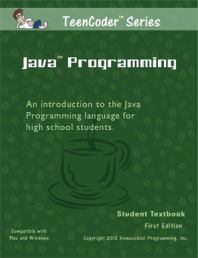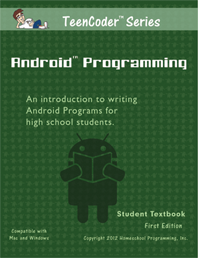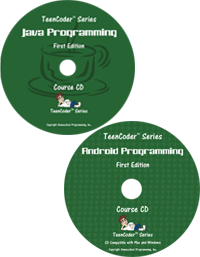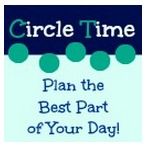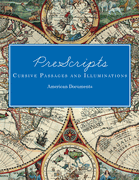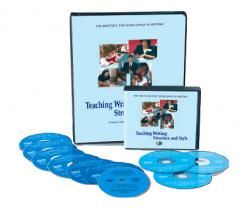Nick was sitting on the couch with a pouty look on his face.
Craig: "What's wrong?"
Nick (7): "I'm bored."
Micah (9) walked by at that moment and replied: "That's a spiritual problem."
Sunday, July 28, 2013
Wednesday, July 24, 2013
On Becoming an Author
Nicholas: "Guess what. My book's only going to have words, no pictures. That's what's taking so long. That's the hard part, thinking of chapters and thinking of words."
That's always been my problem, too.
Review: TeenCoder Java Series
Like many teens today, Luke is very interested in learning to computer program. He was excited to have the opportunity to review the TeenCoder Java Series from Homeschool Programming. This course offers instruction in Java (1st semester) and Android (2nd semester) programming. We received the Java Year Pack, including instructional videos, and it is priced at $155. It is intended for grades 9 and up.
"It strengthened my understanding of different programming fundamentals. It got kind of boring, but I still learned a lot, so being boring didn't matter that much. The DVDs were probably the most helpful part. I liked the layout of the program once I got everything downloaded. The student guide was easy to understand. The projects helped me understand the Java programming language. I plan on finishing the course and look forward to learning more. I would recommend this to any friends who might be interested in learning Java."
I liked that I could be pretty much hands off, and Luke could explore his interest in programming. If you've got a high school student wanting to learn Java and/or Android programming (or another language), take a look at the offerings from Homeschool Programming.
For more reviews of Homeschool Programming courses , visit the Schoolhouse Review Crew.

The course offerings from Homeschool Programming begin with levels aimed at 4th grade and up. They are written by homeschool parents who are also software engineers. The courses are self-study, so they don't require that the parent know anything about the programming language their child is studying, which is fabulous if you have no interest or time (like me) to learn programming.
There are no pre-requisite for the Java course, but the Java course is a pre-requisite for the Android programming course. You won't need to purchase any additional software to use this course. As a bonus, this course can be used to study for the AP Computer Science A exam!
In the Java semester, your student will learn:
- Introduction to the Java programming language
- Creating graphical applications
- Using dialog controls
- Java data types and variables
- User input and flow control
- Math functions and string operations
- Java debugging and exception handling
- Object-oriented programming concepts
- Classes, inheritance, and polymorphism
- Collections, sorting, and recursion
In the Android semester, your student will learn:
- Introduction to the Android Development Tools
- Understanding and editing XML files
- Creating and switching between screens
- Managing Android screen layouts
- Using graphical Android UI widgets
- Saving data to internal storage and SD cards
- Debugging using the emulator
- Displaying images and loading image resources
- Progress, date/time, and alert dialogs
- Menus and notifications
- SMS messaging and networking concepts
- Creating home app widets
- Using Location (GPS) services
- Publishing to the Android Market
We received a download of the TeenCoder Java Series, along with instructional DVDs. You can view a sample student lesson of the Java series here, and the Android series here. The download has an easy to navigate menu that allows you to jump from one PDF lesson or activity to the next. There is a separate easy to navigate menu for the solutions and tests. The instructional DVDs are not needed, but they are well done and a nice addition to the program. You can view a sample from the Java DVD here.
When this course arrived, I gave Luke the link to download the manuals and handed him the DVDs and told him to work on it. He's got such an interest that it didn't take any prodding at all to get him going. Here are his thoughts and opinions:
"It strengthened my understanding of different programming fundamentals. It got kind of boring, but I still learned a lot, so being boring didn't matter that much. The DVDs were probably the most helpful part. I liked the layout of the program once I got everything downloaded. The student guide was easy to understand. The projects helped me understand the Java programming language. I plan on finishing the course and look forward to learning more. I would recommend this to any friends who might be interested in learning Java."
I liked that I could be pretty much hands off, and Luke could explore his interest in programming. If you've got a high school student wanting to learn Java and/or Android programming (or another language), take a look at the offerings from Homeschool Programming.
For more reviews of Homeschool Programming courses , visit the Schoolhouse Review Crew.

Review: Circle Time
Preschoolers and Peace recently sent a download of the eBook, Circle Time: Plan the Best Part of Your Homeschool Day! for review.
Priced at $4.99, this little gem packs quite a punch. Don't let the name "Preschoolers and Peace" fool you. Since my youngest is now in 2nd grade, I'm well out of the preschooler phase. Despite that, I still found a lot of helpful information packed into the 33 pages of this book.
So, what is Circle Time? It's basically a time when you gather all your children together and work on learning the same things. It can include anything you might want to teach: Bible, prayer, memory work, etc. It's a great way to teach your youngest students to sit still and engage. Circle Time can be as long or as short as you and your children need it to be. Obviously, a preschooler won't have the same attention span as your elementary or junior high or high school student. Since your high school student will have more school work than your preschooler, you can do a bit with your older students present, and then dismiss them to go work on something else while you continue Circle Time with your younger students.
The author, Kendra Fletcher, uses this little book to help you to create a Circle Time for your family. She has several suggestions for activities, and there are printables included in the PDF download to help you organize and think through what you want your Circle Time to look like.
As I read Circle Time, I was reminded the years we did Sonlight G & H. During those years, I spent a lot of time reading out loud. We would gather in the living room to start our days and I would read all of the Sonlight reading to the boys. The boys declared it the best history ever, and I think it was in part due to the fact we were learning together. This past year we didn't have that and I really missed it. Circle Time has inspired me to reinstate a shared learning time with all the boys.
Our Circle Time plans include:
For more reviews of Circle Time , visit the Schoolhouse Review Crew.

Priced at $4.99, this little gem packs quite a punch. Don't let the name "Preschoolers and Peace" fool you. Since my youngest is now in 2nd grade, I'm well out of the preschooler phase. Despite that, I still found a lot of helpful information packed into the 33 pages of this book.
So, what is Circle Time? It's basically a time when you gather all your children together and work on learning the same things. It can include anything you might want to teach: Bible, prayer, memory work, etc. It's a great way to teach your youngest students to sit still and engage. Circle Time can be as long or as short as you and your children need it to be. Obviously, a preschooler won't have the same attention span as your elementary or junior high or high school student. Since your high school student will have more school work than your preschooler, you can do a bit with your older students present, and then dismiss them to go work on something else while you continue Circle Time with your younger students.
The author, Kendra Fletcher, uses this little book to help you to create a Circle Time for your family. She has several suggestions for activities, and there are printables included in the PDF download to help you organize and think through what you want your Circle Time to look like.
As I read Circle Time, I was reminded the years we did Sonlight G & H. During those years, I spent a lot of time reading out loud. We would gather in the living room to start our days and I would read all of the Sonlight reading to the boys. The boys declared it the best history ever, and I think it was in part due to the fact we were learning together. This past year we didn't have that and I really missed it. Circle Time has inspired me to reinstate a shared learning time with all the boys.
Our Circle Time plans include:
- a read-aloud
- a poetry selection
- poetry memorization
- American artist selection
- listening to music selections
- learning the States & Capitals
- learning the Presidents
Most of our plans (minus the poetry memorization) are centered around our American History studies this year. That's the beauty of Circle Time--you can personalize it and study what you'd like to study. The memories you can create by taking the time to share learning like this are wonderful--Circle Time isn't something that you'll regret spending time on.
As you plan for this coming year, I'd highly recommend that you get a copy of Circle Time and add a group learning time to your day!
For more reviews of Circle Time , visit the Schoolhouse Review Crew.

Friday, July 19, 2013
Thursday, July 18, 2013
Review: Tunnel of Gold
Goldtown Adventures is a new historical fiction series, written by Susan Marlow. They can be purchased at Susan Marlow and Kregal Publications for $7.99 each. We received the second book in the series, Tunnel of Gold.
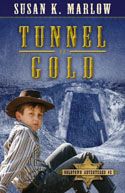
For more reviews of Susan Marlow's Goldtown Adventures books , visit the Schoolhouse Review Crew.


The Goldtown Adventures series is set in the 1864, which is near the end of the Gold Rush in Goldtown, California. In Tunnel of Gold, Jem is caught in a miners' riot when the mine runs out of gold. The miners want to reclaim an airshaft to try and get the mine running again, but the Chinese miners have been lawfully working this area. Tough decisions have to be made when his father, the sheriff, is told that he needs to kick the Chinese miners out of their mine or lose his job.
Author Susan Marlow (a twenty year homeschooling veteran) has spent time travelling in California, visiting old gold camps and learning how miners lived. She puts this knowledge to use in her Goldtown Adventures series. The books are written for ages 8-12, and Tunnel of Gold is 144 pages long. The book is broken down into 18 chapters, which keeps the chapters short enough that reluctant or new readers aren't intimidated, and also makes them a great length for reading the book aloud.
Tunnel of Gold is a very fun read. I was concerned that we might not fully understand the plot, since it is the second book in the series, but that wasn't an issue at all. The plot is engaging, and it was hard to stop at the end of a single chapter. I like that it's a wholesome story, with good values taught.
Whether you're studying the Gold Rush time period, or just looking for a fun adventure series, check out the Goldtown Adventure series from Susan Marlow.
For more reviews of Susan Marlow's Goldtown Adventures books , visit the Schoolhouse Review Crew.

Tuesday, July 09, 2013
Review: Classical Conversations PreScripts
Many homeschoolers have heard of Classical Conversations. They are best known for their communities across the country, where parents and children gather together to study and learn using a classical education model. They've recently designed a series of four cursive books, called PreScripts, that combine art and penmanship. We received PreScripts Cursive Passages and Illuminations, which is the 4th book in the series.
For more reviews of Classical Conversations PreScripts books (all levels) , visit the Schoolhouse Review Crew.

The PreScripts books increase with difficulty as you move through the four books. The first book begins with letter formation and coloring, while the fourth book has your child copying passages from American documents and creating illuminated letters (using the Zaner-Bloser style of cursive). These books are not labelled with grade levels, though there are general age guidelines for each book (Cursive Passages and Illuminations is recommended for ages 9 through high school).
We're starting our new school year, and we're studying American history this year. Cursive Passages and Illuminations was a wonderful fit for our family, since it uses passages from American documents as copywork. Your child will copy the Declaration of Independence, the Monroe Doctrine, the Gettysburg Address, Reagan's Speech at Brandenburg Gate ("Mr. Gorbachev, tear down this wall!"), along with many other important and memorable writings and speeches from American history. After each page of copywork, the facing page has an illuminated letter for your child to copy. You can check out sample pages here.
Priced at $12.99, this book is a bargain. The quality is impressive: a thick and shiny cover, heavyweight paper inside, and a spiral binding so the book lays flat. It can be used as a consumable workbook, or your child can copy the passages and illuminations into their own notebook.
I used this with all 5 of the boys. In the preface of the book, it is stated that "The key to good writing is daily practice". Keeping this in mind, I had my boys practice for 10 minutes a day (I knew some of my boys would balk at having to copy an entire passage--some are quite long). The first thing I had them do when they began a new page was to read what they were copying, since reading cursive still requires them to think through the letters. After they read, I had them copy the passage, in their best cursive, for 10 minutes. I told them it didn't matter how far they got, as long as they were doing their best work. After they finished the passage, they then spent their 10 minutes of penmanship practice time working on their illuminated letters.
The boys enjoyed this copybook. The illuminated letters were a reward; they enjoyed the break of having to write. I liked that even though they weren't writing, they were still using the same fine motor skills they need for penmanship. It's nice having ready made copywork that coordinates with our studies as well. If you're looking for a fun and creative way to practice and teach cursive, check out the line of PreScripts books from Classical Conversations.
The boys enjoyed this copybook. The illuminated letters were a reward; they enjoyed the break of having to write. I liked that even though they weren't writing, they were still using the same fine motor skills they need for penmanship. It's nice having ready made copywork that coordinates with our studies as well. If you're looking for a fun and creative way to practice and teach cursive, check out the line of PreScripts books from Classical Conversations.
For more reviews of Classical Conversations PreScripts books (all levels) , visit the Schoolhouse Review Crew.

Tuesday, July 02, 2013
Unlikely Science
Nick's hair is long (it's wavy/curly, so it appears a bit longer than shoulder length, but when you stretch the curls out it's not quite mid-back length). We've been fighting a lot of tangles lately, and I asked for advice from some friends and one recommended the Wet Brush and a spray bottle of water with some conditioner added.
We tried it, and it worked great. The tangles are removed easily and there is no pulling or tugging to get them out.
But I didn't know it would turn into a science experiment.
Nick: "Mom. It took me 4 minutes 21 seconds to brush my hair this morning."
Me: "You timed it?"
Nick: "Yes, I did. And tomorrow I'm going to use the blue comb and water and time it to see how much faster this way is."
I'm resisting the urge to have him make a graph.
We tried it, and it worked great. The tangles are removed easily and there is no pulling or tugging to get them out.
But I didn't know it would turn into a science experiment.
Nick: "Mom. It took me 4 minutes 21 seconds to brush my hair this morning."
Me: "You timed it?"
Nick: "Yes, I did. And tomorrow I'm going to use the blue comb and water and time it to see how much faster this way is."
I'm resisting the urge to have him make a graph.
Monday, July 01, 2013
Review: Institute for Excellence in Writing
A recurring theme here is the fact I don't consider myself to be a good writing teacher. I can write, but it's just so hard for me to teach it. Institute for Excellence in Writing sent me two products to review, and I had high hopes they might transform me into a great writing teacher.
Teaching Writing: Structure and Style (TWSS) and Student Writing Intensive Level B Set (SWI) were the two products sent. TWSS is the teacher training portion, while SWI allows your student to experience Andrew Pudewa's teaching.
As you watch the DVDs, you are instructed to pause at certain points to work through exercises yourself. You can't teach what you don't know, and this forced me to really practice and engage. This program really breaks teaching writing down into easy steps (more than once I smacked my forehead and wondered why I hadn't thought of a point made), and it made me more confident as a teacher. I like that I can use what I've learned with all the different ages that I'm schooling. I plan to watch these again throughout the year as we reach new units, and will hold another teaching writing workshop for myself next summer and work through all the DVDs again. I imagine this will be a resource I pull of my shelf again and again.
For more reviews of Institute for Excellence in Writing (TWSS, SWI A, B, & C, and Teaching the Classics) , visit the Schoolhouse Review Crew.

Teaching Writing: Structure and Style (TWSS) and Student Writing Intensive Level B Set (SWI) were the two products sent. TWSS is the teacher training portion, while SWI allows your student to experience Andrew Pudewa's teaching.
Teaching Writing: Structure and Style (TWSS)
TWSS ($169) includes 10 DVDs and a Seminar Workbook. The Seminar Workbook is a nice, heavy duty binder, and it serves as a syllabus for the course. There are 10 tabs, and included are outlines for the DVDs, practice pages so you can practice what you're learning to teach, examples from students, suggestions for teaching, charts, and more.
Six of the included DVDs teach through the 9 main units of the program, as well as the stylistic techniques, one DVD contains Tips & Tricks for teaching through these units, and the remaining three DVDs are sample student writing workshops (elementary, intermediate, and high school level). The 9 units of TWSS are:
- Units 1-2: Notemaking & Summarizing from Notes
- Unit 3: Summarizing Narrative Stories
- Unit 4: Summarizing References & Writing Reports
- Unit 5: Writing from Pictures
- Unit 6: Writing Reports from Multiple Sources
- Unit 7: Creative Writing with Structure
- Unit 8: Essays: Basic, Extended, and Super
- Unit 9: Critiques, Conclusion
I held a teaching writing workshop for me using the TWSS disks. I spent a lot of time wishing I'd watched these back when Luke was in early elementary. I found Andrew Pudewa to be an engaging teacher, and I was pleased with the amount I learned. There are 10 hours of teaching, and you can watch all 10 hours at once, or you can watch each unit as you're ready to teach it.
As you watch the DVDs, you are instructed to pause at certain points to work through exercises yourself. You can't teach what you don't know, and this forced me to really practice and engage. This program really breaks teaching writing down into easy steps (more than once I smacked my forehead and wondered why I hadn't thought of a point made), and it made me more confident as a teacher. I like that I can use what I've learned with all the different ages that I'm schooling. I plan to watch these again throughout the year as we reach new units, and will hold another teaching writing workshop for myself next summer and work through all the DVDs again. I imagine this will be a resource I pull of my shelf again and again.
Student Writing Intensive: Level B (SWI-B)
SWI-B ($109) is for students in grades 6-8, though it can be adjusted up or down if you're teaching multiple grades. This program also comes with a heavy duty binder, along with dividers, and a packet of papers that includes teaching notes, scope & sequence, course schedule, student worksheets, and charts. Each student doing the program will need a student binder, but permission is given to copy for use within a family (if you don't want to do this, you can purchase an additional binder & packet). In addition to the binder, DVDs are included. There are four DVDs that teach directly to the student, along with a Structure and Style Overview for the teacher.
I've been working through SWI-B with all 5 boys (grades 2, 4, 6, 8, & 9). There are 3 levels of SWI (A, B, and C), and B is recommended if you're working with an age range. There are even Level A reinforcement paragraphs available for download to use along with SWI-B.
There is a suggested 30 week course schedule included, which makes implementation extremely easy. You'll want to be flexible with this, though, and spend as much or little time as needed on the specific skill set that you're working on. The basic plan, though, is that you and your students watch the teaching DVD, and then work through the skill on your own. Since there isn't a teaching DVD for every lesson, it's very important that you've watched the TWSS DVD that teaches you how to teach the skill, so you can work through it with your children.
Everyone starts out learning to write key word outlines from a simple paragraph or story and then rewriting the paragraph from the key word outline. Lessons progress from here, until the student is writing multiple paragraphs by the end of the course. I've just finished reading The Autobiography of Benjamin Franklin, and was struck by the fact that he learned to write using this method.
In addition to the structure content, a style component is also taught. Students are taught to vary their sentences, by adding adverbs, clauses, and other "dress-ups". There is a checklist for each composition that directs the student in how many and what type of "dress-ups" should be used.
My boys love Andrew Pudewa, and would've watched him teach every day if they could. He's a very entertaining and engaging teacher, and he made writing fun. My boys laughed out loud several times due to Mr. Pudewa's sense of humor. All of the boys have learned to write paragraphs from key word outlines, though my 2nd grader needs some help (however, I learned in TWSS that this is perfectly okay!). They've learned to double space their rough drafts, they've learned that editing is okay and to be expected, and they've learned how to spice up their writing by adding some required "dress-ups".
I have had 8 weeks with this program to review it, and I've seen a lot of improvement in my boys' writing. I really regret not purchasing this earlier on in our homeschooling journey. I feel like I've learned so much and gained so much confidence from working through these programs. If you're looking for a program that teaches you how to teach writing, and holds your hand while you get your teaching feet under you, check out the TWSS/SWI combo from Institute for Excellence in Writing.
For more reviews of Institute for Excellence in Writing (TWSS, SWI A, B, & C, and Teaching the Classics) , visit the Schoolhouse Review Crew.

Subscribe to:
Posts (Atom)

